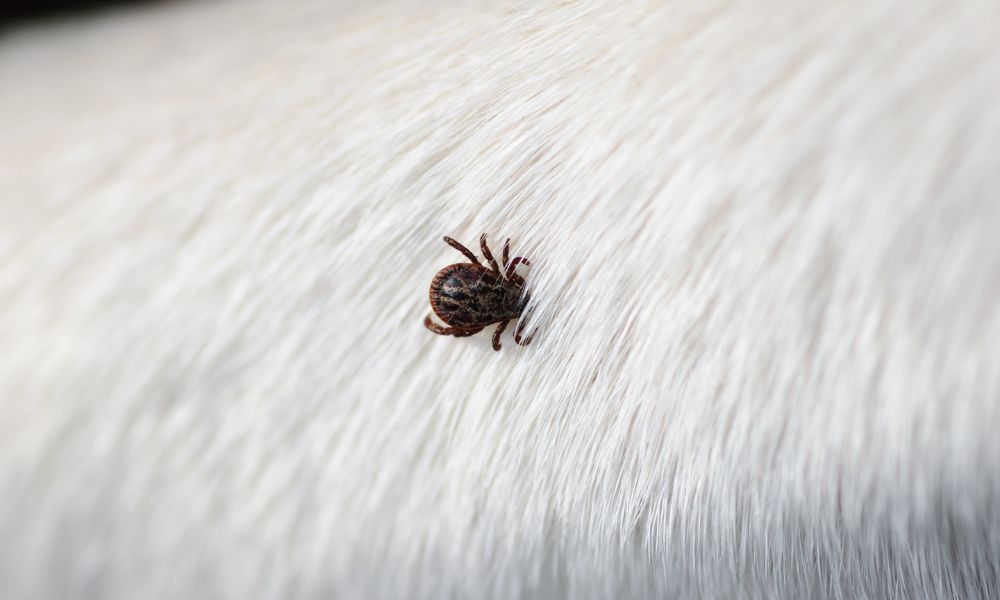The onset of warmer weather brings with it a resurgence of outdoor activities, but for our furry companions, this transition may signify the start of a dangerous season. Tick bites in pets are an annoyance that can lead to serious health complications. Understanding the risks, recognizing the signs, and taking necessary precautions is essential for pet owners who wish to safeguard their beloved animals against the perils of these tiny parasites. Continue reading for an overview of the dangers of tick bites in pets.
What Are Ticks?
Tick infestations are a perennial health concern for pets and their owners alike. Ticks are parasites that feast on the blood of mammals, birds, and sometimes reptiles and amphibians. They serve as vectors for various diseases and can transmit pathogens that cause illnesses, including Lyme disease, anaplasmosis, and ehrlichiosis. For pets, particularly dogs and cats, tick bites can lead to significant health issues and, in severe cases, even be fatal.
The most prevalent tick species that afflict our pets include the American dog tick, the brown dog tick, and the deer tick. These ticks reside in a variety of environments, from grasslands to wooded areas, and can transmit a variety of diseases to the pets they’ve bitten.
Lyme disease, perhaps the most widely recognized tick-borne illness, can cause joint pain, lameness, and in extreme cases, damage to the kidneys. Anaplasmosis often results in symptoms similar to Lyme disease, with the addition of vomiting and diarrhea. Ehrlichiosis causes flu-like symptoms and affects the blood cells. Without treatment this disease can progress to the point of affecting various organs. The array of conditions that ticks can carry showcases the numerous reasons vigilance and protection are essential.
Identifying Tick Bites in Pets
At first glance, a tick that’s attached itself to your pet may be hard to find, especially in areas with thick fur. However, vigilance is critical as early detection can prevent illness. Tick bites often present various telltale symptoms that indicate your pet has been bitten.
A careful examination of your pet may reveal the presence of a tick, which appears as a small, rounded arachnid attached to the skin. The affected area might also be red or inflamed, indicative of the body's response to the parasite.
Changes in behavior, including lethargy and a decreased appetite, are common indicators that your pet may be suffering from a tick-borne disease. Lameness, accompanied by swollen or painful joints, could also suggest a potential tick-related illness.
If you suspect your pet has a tick bite, promptly seeking veterinary attention is critical. Your vet can conduct tests that detect whether your pet has contracted a tick-borne disease and can offer guidance on the best course of treatment and prevention going forward.
Preventing Tick Bites
Prevention is always better than treatment, especially when it comes to safeguarding your pet's health. Fortunately, there are several proactive measures pet owners can take to minimize the risk of tick bites.
Maintaining a clean environment is the first line of defense against ticks. Regular outdoor cleaning and yard work, including mowing lawns and clearing tall grass, can significantly reduce the presence of ticks.
Additionally, utilizing tick prevention products, such as collars, sprays, and spot-on treatments, help create a protective barrier that can deter ticks from latching onto your pet. Considering environmental treatments for your home can also mitigate the risk of infestations.
Lastly, certain supplements and medications can strengthen your pet's immune system, making them more capable of fighting off tick-borne diseases. Your veterinarian can advise you on the best options based on your pet's health needs and lifestyle.
Removing Ticks Safely
The discovery of a tick on your pet should not induce panic but rather prompt a calm and careful removal to minimize further complications. To begin, gather necessary tools, such as fine-tipped tweezers or a tick-removal tool, rubbing alcohol, and antiseptic ointment. Do not attempt to remove the tick with your bare hands, as a botched removal can increase the risk of infection.
Grasp the tick as close to the skin as possible and steadily pull upward with even pressure. Do not twist or jerk the tick, as this can cause its mouthparts to break off and remain embedded in your pet. Once removed, wash your hands and clean the affected area with disinfectant or antiseptic cream that is safe for pets. Be sure to clean your tweezers with isopropyl alcohol.
After removing the tick, monitor your pet for any abnormal symptoms. If you notice any signs of illness, consult your veterinarian, who may recommend tests to check for the presence of tick-borne diseases.
Seeking Veterinary Care
Regular check-ups at your pet's veterinarian are crucial, especially for pets at higher risk of tick exposure due to their lifestyle or location. Veterinarians can recommend the most appropriate tick prevention methods for your pet. This may include regular vaccinations and screening for tick-borne diseases.
Should your pet exhibit any symptoms of tick-borne illnesses, prompt veterinary care can aid in diagnosis and intervention. Treatments often involve the administration of antibiotics, and, in more severe cases, supportive therapies may be necessary.
It’s also important to inform your veterinarian about your pet's activities and any signs or history of tick exposure. Early, comprehensive reporting can assist in tailoring effective treatment protocols for your pet's specific needs.
Staying Informed
You should always be aware of the dangers posed by tick bites to pets. Vigilance, education, and preventive measures are the three pillars that support protecting our pets from tick-borne illnesses. By staying informed and taking the necessary precautions, pet owners can ensure their four-legged friends enjoy a healthy, tick-free life.
Take some time this season to educate yourself about ticks and the risks they pose to your pets. Seizing every opportunity to shield your pets from potential dangers is a sign of a responsible and caring pet owner. You may also consider joining local or online pet communities to stay updated on the presence of ticks in your area. Sharing experiences and knowledge can benefit the greater pet community.
Lead the Charge Against Ticks
Take charge this season and make a commitment to protect your pets from tick-borne diseases. Whether it's through regular check-ups, tick prevention, or swift action when you detect a tick, your efforts can make a significant difference in your pet's well-being.
Protecting your pet from ticks when you’re traveling is also important. Vehicle accessories, such as van bug screens from The Bug Wall, can ensure your pet can safely enjoy the outdoors without worrying about uninvited guests. By understanding and applying this overview of the dangers of tick bites in pets, you can help ensure your animal leads a happy and healthy life no matter where you’re headed.









